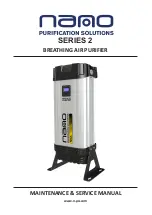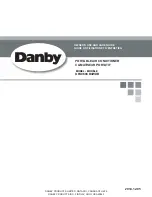
English
9
8-3 General
• Make sure to connect the power supply wire to the power supply ter-
minal block and to clamp it as shown in figure 8, chapter “Field wiring
connection”.
• As this unit is equipped with an inverter, installing a phase advancing
capacitor will not only reduce the power factor improvement effect,
but also may cause the capacitor to overheat due to high-frequency
waves. Therefore, never install a phase advancing capacitor.
• Keep power supply imbalance within 2% of the supply rating.
1.
Large imbalance will shorten the life of the smoothing capacitor.
2.
As a protective measure, the product will stop operating and an
error indication will be made, when power supply imbalance
exceeds 4% of the supply rating.
• Follow the “wiring diagram” when carrying out any electrical wiring.
• Only proceed with wiring work after blocking off all power supply.
• Always ground wires. (In accordance with national regulations of the
pertinent country.)
•
This unit uses an inverter, and therefore generates noise, which will
have to be reduced to avoid interfering with other devices. The outer
casing of the product may take on an electrical charge due to leaked
electrical current, which will have to be discharged with the ground-
ing.
•
This unit has a negative phase protection circuit. (If it operates, only
operate the unit after correcting the wiring.)
WARNING
• Do not ground units to gas pipes, sewage pipes, lightning rods, or
telephone ground wires because incomplete grounding could
cause a severe shock hazard resulting in severe injury or death.
Gas pipes:
can explode or catch fire if there is a gas leak.
Sewage pipes:
no grounding effect is possible if hard plastic pip-
ing is used.
Telephone ground wires and lightning rods:
dangerous when
struck by lightning due to an abnormal rise in electrical potential in
the grounding.
8-4 Examples
System example (Refer to figure 8)
1.
Field power supply
2.
Main switch
3.
Disconnect switch
4.
Fuse
5.
Remote controller
6.
Outside unit
7.
Branch Selector unit
8.
Indoor unit
9.
Cool/Heat selector
power supply wiring (sheathed wire)
transmission wiring (sheathed wire)
CAUTION
• Use a conduit for the power supply wiring.
• Outside the unit, make sure the low-voltage electric wiring (i.e. for the
remote controller, transmission, etc.) and the high-voltage electric wir-
ing do not pass near each other, keeping them at least 5 in. apart. Prox-
imity may cause electrical interference, malfunctions, and breakage.
• Be sure to connect the power supply wiring to the power supply ter-
minal block and secure it as described in
Field wiring connection
.
• Transmission wiring should be secured as described in
Field wiring
connection.
• Secure the wiring with the accessory clamps so that it does not touch
the piping.
• Make sure the wiring and the control box cover do not stick up above
the structure, and close the cover firmly.
WARNING
•
Never connect power supply wiring to the terminal block for remote
controller wiring as this could damage the entire system.
Picking power supply and transmission wiring
(Refer to figure 9)
1.
Power supply wiring and wiring for pump operation
(High voltage)
2.
Transmission wiring
(Low voltage)
3.
Set apart
Connect the wire to the terminal block on printed circuit board with care
since too much pressure may cause breakage of the printed circuit board.
Field wiring connection: transmission wiring, interlock circuit, pump
operation output and Cool/Heat selector.
Power supply and transmission wiring: Connect it using conduit
mounting plates.
[In case of single outside unit]
(Refer to figure 10)
1.
Cool/Heat selector
2.
Printed circuit board (A1P)
3.
Take care of the polarity
4.
Use the conductor of sheathed wire (2 wire) (no polarity)
5.
Terminal board (field supply)
6.
Indoor unit
7.
Never connect the power supply wire.
8.
Branch Selector unit A
9.
Branch Selector unit B
10.
Last Branch Selector unit
11.
Cooling only unit
12.
ABC I/P printed circuit board (A5P)
[In case of multiple outside units]
(Refer to figure 11)
1.
Unit A (Master unit)
2.
Unit B
3.
Unit C
4.
TO IN/D UNIT
5.
TO OUT/D UNIT
6.
TO MULTI UNIT
7.
To Cool/Heat selector (only Heat pump system)
8.
To indoor unit
9.
To other systems
• The transmission wiring between the outside units in the same pipe
line must be connected to the Q1/Q2 (TO MULTI UNIT) terminals.
Connecting the wires to the F1/F2 (TO OUT/D UNIT) terminals
results in system malfunction.
• The wiring for the other pipe line must be connected to the F1/F2 (TO
OUT/D UNIT) terminals of the printed circuit board in the outside unit
to which the transmission wiring for the indoor units is connected.
• The outside unit to which the transmission wiring for the indoor units
is connected is master unit.
• The transmission wiring between the outside units must be 98 ft.
(30 m) in length at maximum.
NOTE
• Be sure to keep the power supply and transmission wiring apart from
each other.
Be careful about polarity of the transmission wiring.
Make sure that the transmission wiring is clamped as shown in the
figure in chapter “Field wiring connection”.
Check that wiring does not make contact with refrigerant piping.
Firmly close the cover and arrange the electric wires so as to prevent
the cover or other parts from coming loose.
[Setting the interlock circuit and pump operation output.]
〈
Pump operation output [high voltage]
〉
• Use insulated wires of the size as mentioned below having rated volt-
age of 250 V or more:
For single core: AWG16 or larger (conduit pipe work)
For multiple cores: AWG18 or larger
*The wiring for pump operation output is to be procured locally.
(Refer to figure 12)
1.
Pump operation output terminal (X2M).
When water pump is linked with system operation, water
pump operation circuit shall be set between terminals (1)
and (2).
Contact specification --- 220 VAC, 3 mA-0.5 A
Top plate
Conduit
(field supply)
Lock nut
(field supply)
Conduit
mounting
plate
(accessory)
Top plate
01_EN_3P365916_17C.fm Page 9 Thursday, March 12, 2015 10:47 AM
Summary of Contents for RWEYQ144PCTJ
Page 28: ...3P365916 17C EM14A009A 1503 HT...














































